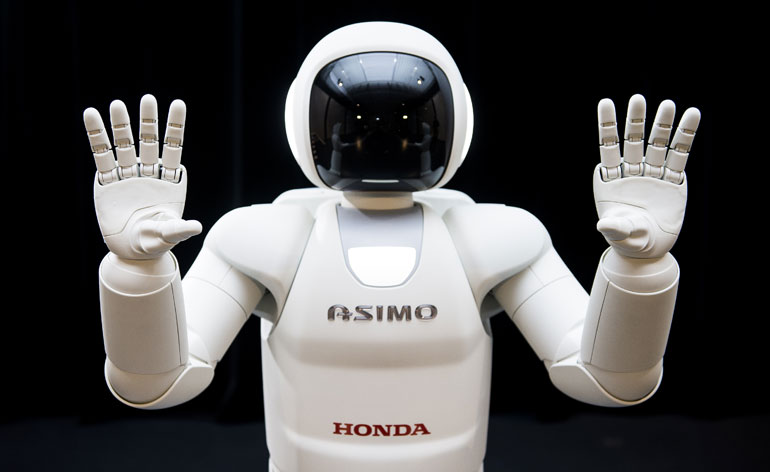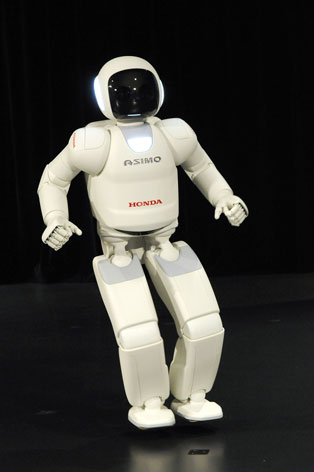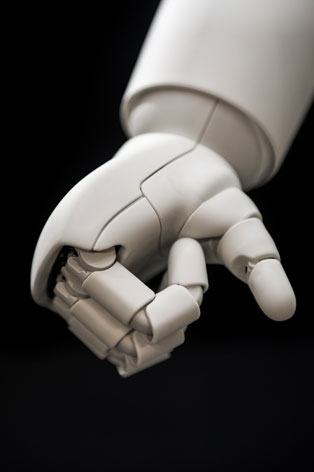Next generation: as Honda's Asimo robot grows up, we quiz engineer Satoshi Shigemi about its future

The future looks good. Honda's Asimo robot has served a dual purpose throughout its 14-year development as an ambassador for the Japanese brand's technical ambitions and as an R&D platform that feeds into all aspects of the conglomerate's business. Its teenage transformation is looking increasingly promising.
We recently travelled to Brussels, the rather incongruous European HQ of Honda's robotics division. Here, in a nondescript business park, Asimo is oiled up and rolled out for press calls and educational trips, as well as receiving endless tweaks from the robotic HQ back in Japan. One such tweak has just arrived, and it's enough for the company to have a global press call and run the little humanoid being through its new tricks.
Before we get to Asimo's party pieces, it's worth ruminating on what the point of robotics actually is. Honda's people shy away from the subject, but we're pretty sure that you won't be able to buy an Asimo any time soon. It seems the stuff of genuine science fiction will stay that way for a few more generations. A genuinely dexterous, intelligent and independent robot would be far too valuable for military and industrial applications before it could be used to serve nightcaps in nursing homes and pushing strollers.
Asimo, the 2014 edition, certainly looks like a special effect. Our pop culture-fuelled preconceptions of how a robot might appear are almost perfectly fulfilled, from the whine of the servo motors to the shiny white carapace and spaceman-like head. Able to run, jump, hop, serve a drink and ascend stairs, Asimo drags us into the uncanny valley, experiencing equal parts fear and delight.
We spoke to Satoshi Shigemi, senior chief engineer of the Asimo project and someone who's spent two decades exploring the potential of humanoid robots...
Wallpaper*: What is your ultimate vision for Asimo?
Satoshi Shigemi: Our ultimate vision is to create an assistant robot that can exist among humans in a household, just like a primary schoolchild who starts helping out around the home.
W*: How far are you along this road?
SS: Three years ago we started trials in real conditions, in a museum where Asimo can give information to visitors, etc. The feedback is very helpful. But the ultimate goal of a mass produced robot for every household is still 10-20 years away.
W*: How do you feel robots are going to be accepted by society?
SS: We believe that because a humanoid robot looks and moves like a human, it brings advantages in communication. Body language can easily be adapted and understood. Asimo is the size of a child. We believe the acceptance will be very high, but always supported by the ability to communication - that's the next step.
W*: Is Honda working on AI research?
SS: It's a very wide field but of course what we're intending Asimo to do will require in part artificial intelligence. In a museum environment, Asimo can register and interact with visitors without any external control.
W*: What is the link between Asimo and Isaac Asimov, the creator of the Three Laws of Robotics?
SS: We find it very impressive that someone thought about and formulated such rules at that time (1942). In basic principle we complete agree with them. But the answer is that the name has no relation - we didn't know about the author when the robot was named. And had we known, we probably wouldn't have chosen it.
W*: Will different cultures have different ways of reacting to robots?
SS: In Japan the emotional level of a robot is very important. Perhaps it's because of our many robot characters and heroes in manga - there's a positive feeling. We believe robots need to have these characteristics so they can co-exist with humans.

The new Asimo is able to run, jump, hop, serve a drink and ascend stairs

Honda's goal is 'to create an assistant robot that can exist amongst humans in a household', explains senior chief engineer Satoshi Shigemi

Asimo's body comprises a magnesium alloy coated with a plastic resin, making it both lightweight and durable

Its hands, meanwhile, have independent opposable thumbs and are equipped with a kinesthetic force sensor, allowing it to carry odd-shaped objects and also sense the direction and amount of force on the hand

Our preconceptions of how a robot might appear are almost perfectly fulfilled, from the whine of the servo motors to the shiny white carapace and spaceman-like head
Receive our daily digest of inspiration, escapism and design stories from around the world direct to your inbox.
Jonathan Bell has written for Wallpaper* magazine since 1999, covering everything from architecture and transport design to books, tech and graphic design. He is now the magazine’s Transport and Technology Editor. Jonathan has written and edited 15 books, including Concept Car Design, 21st Century House, and The New Modern House. He is also the host of Wallpaper’s first podcast.
-
 Mexico's Office of Urban Resilience creates projects that cities can learn from
Mexico's Office of Urban Resilience creates projects that cities can learn fromAt Office of Urban Resilience, the team believes that ‘architecture should be more than designing objects. It can be a tool for generating knowledge’
-
 ‘I want to bring anxiety to the surface': Shannon Cartier Lucy on her unsettling works
‘I want to bring anxiety to the surface': Shannon Cartier Lucy on her unsettling worksIn an exhibition at Soft Opening, London, Shannon Cartier Lucy revisits childhood memories
-
 What one writer learnt in 2025 through exploring the ‘intimate, familiar’ wardrobes of ten friends
What one writer learnt in 2025 through exploring the ‘intimate, familiar’ wardrobes of ten friendsInspired by artist Sophie Calle, Colleen Kelsey’s ‘Wearing It Out’ sees the writer ask ten friends to tell the stories behind their most precious garments – from a wedding dress ordered on a whim to a pair of Prada Mary Janes